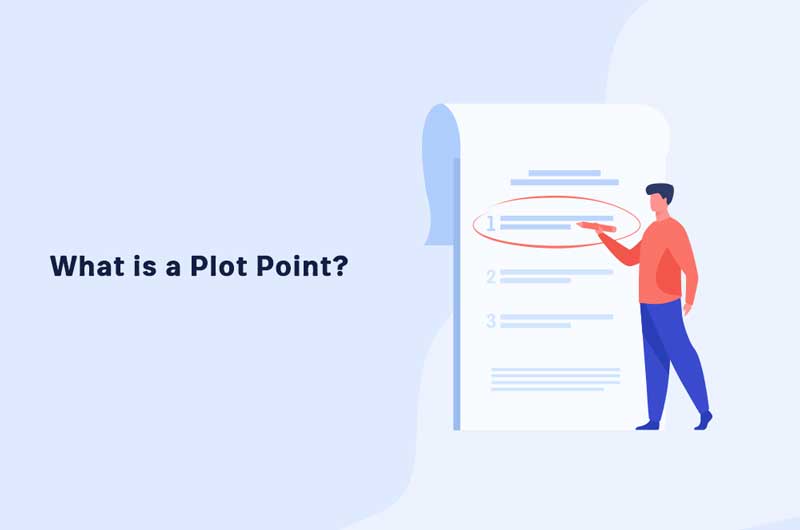While some stories focus entirely on only one or two characters, most have several that are present throughout the story. The main character is, of course, the biggest focus. And a flat character does not carry as much importance.
Becoming familiar with the workings of a flat character is essential in knowing how to write a novel. Familiarizing yourself with examples will help you learn how to become a better writer, too.
What is a flat character? They are characters that are mostly one-dimensional and don’t have a lot of backstory or depth. Most of the time, they also remain relatively unchanged from the beginning of the story to the end.
Secondary characters are often the flat characters of the story. They are not the ones readers are supposed to be connecting with the most. This is important to remember when learning how to write a book.
The idea of a flat character comes from E.M. Forster. He writes about it in his exceptionally useful book Aspects of the Novel.
Characteristics of a Flat Character
A flat character is not as interesting as its opposite, the round character. Most flat characters, while different in the details, are the same at their core.
Several things make up a typical flat character. Knowing them will help you learn how to write a novel and how to become a better writer in general.
- They are there to support the main character.
- Not as important to the story as a whole.
- They usually don’t go through any substantial change or growth throughout the story.
- Flat characters will have elements and traits that are recognizably stereotypical.
- These characters have a limited scope of perspective and opinions.
- A flat character is not necessarily boring, weak, or poorly written. All it means is that they are one-dimensional and not interesting. They don’t draw attention away from the important characters.
- They have a single role in the story. For example – the overbearing mother, annoying cousin, and competitive coworker.
- Common and frequent in plot-driven stories. The characters are made flat so that the reader places their focus on the plot.
A Flat Character is Not a Bad Character
Many people think that the term “flat character” is a criticism or description of how a character is written. This is not always the case. Of course, if your character is supposed to be round and it falls flat instead, this is a problem.
But, a character that is intentionally flat can serve a significant purpose in a story. Knowing how to write a book is knowing exactly what kind of characters you are going to use.
They are Memorable and Understandable
Indeed, readers don’t tend to relate to a flat character because they are not life-like and complex. However, flat characters are often easy to understand because they follow formulas that are recognizable and familiar.
Even though they are not deep characters that readers are invested in, they will understand the character’s purpose. They understand where they fit into the story and why they are there.
These characters are also remembered because of the value they add to the story. They are not necessarily representative of the story’s value but they bring something to the table that makes the story better.
Practice writing your flat characters to know how to become a better writer. They advance the narrative.
They tend to be most effective when used more comically. A flat character that is tragic or too serious will end up being a bore.
A Flat Character Adds Value
A good example of a flat character advancing a storyline in a valuable way is Mrs. Micawber from Charles Dickens’s David Copperfield. She comes from a well-off family. The family disapproves of her husband, who has a kind heart but not a lot of money.
She has determined that she will never leave him. She is flat because she is defined only by her unending devotion to her husband.
Though this is her only notable characteristic, she still adds value to the overall story by contributing to the narrative of the working class and their issues.
Studying a character like this helps you learn how to write a novel.
Flat characters add something to the story without drawing too much attention to themselves. In the above example, Mrs. Micawber is known only for being devoted to her husband. From this, we can know she is a loyal woman who loves her husband.
We don’t know much else, and that’s the point. We take her for what she is. This allows us to keep our emotional focus on the characters who have more to offer, and more story to tell.
Exposition
An author may use a flat character as a way to reveal important details or information. Information dumps are a well-known writing faux-pas. If your first chapter or two is just a big list of information, no one will continue reading.
To avoid boring and overwhelming their readers, writers often have to get creative when it comes to the revelation of important information.
This is where flat characters become useful. Rather than spitting out tons of narration, the writer can have one of these side characters reveal some details instead. This can be through their words or even their actions and reactions to certain characters or situations.
Henchmen
In addition to using a flat character to reveal information, they are often created as an evil character that the readers aren’t supposed to like. Unless the evil character is a significant part of the story, they shouldn’t change much. They shouldn’t be growing a conscience or feeling any guilt.
If an evil side character did this it could drastically change the direction of the story. Their unchanging state helps readers to understand the place of this character.
It also allows them to stay detached and not be disappointed when the character is eventually disposed of.
Quest-Givers
Another example of these unchanging, one-dimensional flat characters that add value are the “quest-givers” in a fantasy.
These characters are small and secondary but they advance the plot by sending the protagonist on a mission or job of some sort. They can also be used to reveal pertinent information to the protagonist specifically.
If these characters were to be complex and detailed with emotions and backstories, readers would be getting invested in the wrong people.
If these “quest givers” became dynamic and grew and changed throughout the story, the story would be about them.
They are not fleshed out. They are not interesting, but they advance the plot importantly.
Flat Character Examples
Almost every story you read will have examples of flat characters. Some are there for only a chapter while others are present throughout. Either way, they all have a purpose and serve to advance or complicate the plot.
Flat Characters in the Classics
Classics are classics for a reason. A story doesn’t go down in history for being plain or boring. Not only do these classics give us timeless, well-told stories, but they show how good books are written. Part of this is their clever and effective use of flat characters.
Hamlet
Shakespeare has a solid example of a flat character in Gertrude from Hamlet. She is loving and caring towards Hamlet, but inside she is weak and oblivious. She has been duped by Claudius who murdered her husband and stole the throne.
Gertrude doesn’t understand why Hamlet is opposed to her marriage. Though she is weak, she serves to advance the plot by being a pawn for Claudius and Polonius. They are able to use her to carry out their plans and schemes.
Romeo and Juliet
Romeo and Juliet has two perfect examples of flat characters. First, we have Juliet’s mother. Hardly anything is revealed about her at all.
Her sole purpose is to try and convince Juliet to marry Paris. She has a simple personality but her role is important. This pressure to be with Paris is a big conflict in the story.
Next, we have Benvolio. We know that he is a good and loyal friend to Romeo. He is accused by some of being hot-headed and having a bad attitude.
Beyond this, however, we don’t know a lot and he remains unchanged throughout the story. He does advance the plot by trying to play peacekeeper between the families. He also supports Romeo in going after Juliet.
Dracula
The famous vampire from Bram Stoker’s Dracula is an example of a main character who is also a flat character. Dracula is a nobleman who is also a vampire.
He is visited by Jonathan Harker, a solicitor.
Dracula is gracious and polite, though it doesn’t take long for Harker to realize he has been taken, prisoner.
His fiance and her friend soon arrive and become “infected” by Dracula, who sucks their blood and leaves them to also become vampires. This is Dracula’s only goal.
The story follows a complex and interesting plot, but Dracula is not a complicated character. All he ever aspires to do is suck blood and turn people into vampires.
These simple, unchanging desires coupled with his one-dimensional personality make him a flat protagonist.
Harry Potter
The world of Harry Potter is a complex and expertly crafted story. Harry himself is a round character, but J.K. Rowling makes brilliant use of several flat characters to advance the story in unique ways.
Crabbe and Goyle are both examples of a flat character. They are present throughout all the books, but we still never learn much about them.
They are Draco Malfoy’s friends/sidekicks. Readers are very familiar with them but don’t know much beyond their surface-level personalities.
They serve a purpose within the story – they help Malfoy carry out his schemes – but they aren’t anyone’s main focus. Readers are not emotionally invested in them and probably don’t care much about what happens to them.
Another example here is Hagrid. Hagrid is central to the plot. He is a recognizable and important character. He is someone Harry can go to and trust. Hagrid is well-loved by both characters and readers.
All of that said, there isn’t much there to analyze.
But, Hagrid plays a crucial role in the story. His first job is to track Harry down after the letters aren’t working. From there, he helps and advances the plot in several ways, but he never changes.
Hagrid doesn’t experience much growth. And though he is essential to the plot, we don’t get a very deep look into his actual personality.
Flat Character Examples in Disney
While also considered classic by many, Disney has truly carved itself into a category of its own. With multiple movies containing simple but memorable characters, they offer some notable examples of flat characters.
Ariel
While she is the main focus of the story, Ariel is flat due to her unwavering obsession with what dwells above the surface of the ocean. She “wants to be where the people are” and it’s all she ever thinks about.
Her appearance does change, but she remains the same. Even when she makes it onto the land, she still fixates on the life of humans by turning her attention to Eric.
She becomes involved with him rather fast. Her personality is basic and she is naive. She never grows from this.
Gaston
Gaston is quite obviously a few things:
- Mean
- Arrogant
- Prideful
- Cold
- Hard-hearted
- Attention-seeking
This is all we know about him, however, and he never redeems himself. His personality is stagnant and his motivation is singular: marry Belle.
Though he is shallow and static, he plays a significant role as a source of conflict. Belle is slowly getting through to the beast during her time in the tower. The breaking of the curse would have gone through unhindered if it hadn’t been for Gaston and his attempt to kill the beast.
Cinderella’s Stepmother
Lastly, we have Cinderella’s iconic stepmother. She is mean, cruel, and downright evil. Her intentions are bad and that’s the end of it. She remains this way throughout the entire story, never experiencing redemption or growth.
She is crucial to the story, however, as she stands in the way of Cinderella reaching her full potential in life. Without the stepmother and her strict, unreasonable rules, Cinderella would have had no trouble staying at the ball.
She would have married the prince without issue and it wouldn’t have made for a very interesting story.
Don’t be Afraid of a Flat Character
As a writer, you shouldn’t fear the flat characters. Some place them in a bad light as characters who are poorly written and not well thought out.
While this can be true, flat characters can also be effective and downright essential to your storyline.
When used correctly, these characters play significant and important roles. They not only advance the plot but they do so in ways that don’t draw attention to themselves.
They make an impact on the story while allowing the reader to stay focused on the main characters.
So, don’t be afraid to include some flat characters. They can be of help to you when used intentionally. When you know how to write a flat character, you are on your way to learning how to write a book.


![How to Write a Fantasy Novel that Gets Read in 8 Steps [+Template]](/learn/wp-content/uploads/2021/12/How-to-Write-a-Fantasy-Novel-that-Gets-Read-in-8-Steps1.jpg)
![Novel Structure: Create One That Works [+Checklist]](/learn/wp-content/uploads/2021/12/Novel-Structure-Create-One-That-Works-21.jpg)








